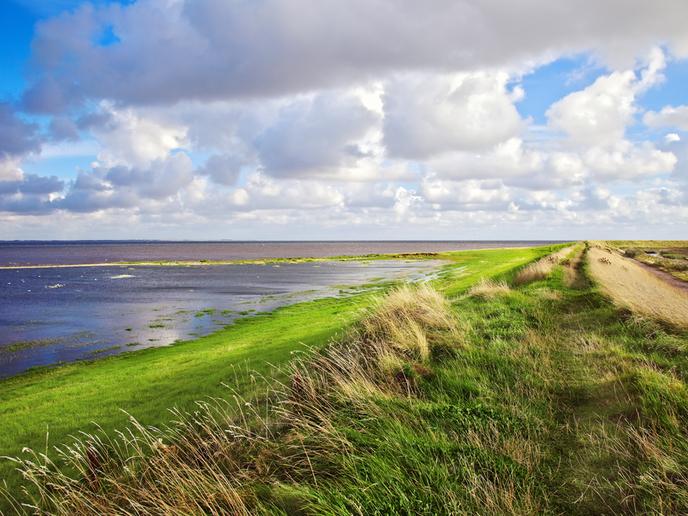Restoring coastal ecosystems, such as wetlands or dunes, to prevent erosion and reduce flood risks is an efficient solution to address the challenges of rising sea levels with a much lower carbon footprint than building concrete breakwater blocks.It’s a solution that addresses the challenge of rising sea levels, while at the same time limiting our output of CO2 emissions. By increasing the coast’s capacity to absorb and store carbon in the plants and the soil below, this nature-positive approach is clearly a win-win for the environment and society. Other benefits include, for example, improved water quality in the case of coastal wetlands or contributing to our well-being through cultural and recreational opportunities.Nature delivers a wide range of services that support the balance of life. For example, ecosystems can adapt to changes in temperature and rainfall and shield us from the worst effects of climate change. Wetlands do this by absorbing and retaining water to prevent floods, and in coastal areas they can reduce soil mobility and thereby prevent erosion.Restoration: bringing nature back into the gameWindfarms, solar panels, green hydrogen fuel and the like are important innovations to decarbonise our energy. To rebuild more sustainable societies we need to work with the vast powers already in place around us.“Most of the projects have been small scale, they’ve often been initiated by NGOs, and they have had as their objective to restore biodiversity or local habitats.Dr Craig Bullock, WaterLANDSDespite the many examples of potential nature-based solutions across Europe, most of the projects have been so far at small scale. ‘They’ve often been initiated by NGOs, and they have had as their objective to restore biodiversity or local habitats,’ said Dr Bullock, an environmental economist from University College Dublin. ‘They generally haven’t looked at the human issues that we need to address in relation to adaptation to climate change.’Large projects are needed to address the social issues like flooding, coastal erosion and water quality, according to Dr Bullock, who is coordinating research on wetland nature-based solutions under theWaterLANDSproject. It’s part of the European Commission’s Green Deal ambition to make Europe the first climate neutral continent by 2050 with a sustainable economy that leaves no one behind. The project will officially launch in December 2021.‘To bring about fundamental changes in terms of climate change in particular, you also need large-scale projects. You are not going to be able to store huge amounts of water in small wetland areas to prevent large-scale downstream flooding,’ added Dr Bullock.“We will work very intensively with four economic sectors that we think are interested in restoration and can benefit from restoration.Professor Daniel Hering, MERLINSolutions also need to be cost-effective and address multiple benefits, not only for nature but also people, according to Daniel Hering, an expert in aquatic ecology and professor at the University of Duisburg-Essen. He lists four reasons why the uptake of nature-based solutions is slow. ‘It’s a matter of money, of planning, public involvement and policy.’As the coordinator of the ambitiousMERLINproject, which is one of four flagship restoration projects in the EU Green Deal, Prof. Hering will bring economic sectors into the game. He will show them why supporting ecosystem restoration can be a profitable investment while at the same time providing benefits for the climate, biodiversity and society.‘One of the main targets of the European Green Deal is to engage economic sectors in restoration and nature-based solutions. This is also at the heart of MERLIN: we will work very intensively with four economic sectors that we think are interested in restoration and can benefit from such activity.’“Restoration and nature-based solutions need time to be implemented and time to develop.Professor Agustín Sánchez-Arcilla, REST-COASTThis includes the agricultural sector, where there is a common interest with respect to organic agriculture and sustainable use of floodplains, for example. MERLIN will also work with water supply companies who can benefit from improved water quality that restoration activities bring. Also, the navigation and insurance industries will be engaged; the latter is especially relevant in light of the heavy floods that many European countries experienced in the summer of 2021.Identifying common interests and benefits of restoration is one thing; recognising that there is no easy fix or quick return on investment when you join forces with nature is another.‘Restoration and nature-based solutions need time to be implemented and time to develop,’ said Professor Agustín Sánchez-Arcilla of Catalonia University of Technology, who coordinates the new Green Deal projectREST-COAST, which looks at upscaling the restoration of coastal ecosystems.In looking at coastal ecosystems as a whole, including the rivers, estuaries, and deltas that are connected to the coasts, the project is highlighting the importance of expanding cooperation when it comes to restoration activities in Europe.‘We can build a breakwater out of concrete to protect our coasts in a matter of months,’ he said. ‘But if you need a coastal system to properly develop, with a seagrass meadow and vegetation protecting the beach, that may take some years. And then as it progressively grows, it will take more years to fully deliver the ecosystem services, which could be protection against erosion or against flooding.’Developing cross-border actions is also important. For instance, several REST-COAST pilot cases involve three countries, such as the Wadden Sea, which is between the Netherlands, Germany and Denmark. ‘More integration is one of the governance barriers we aim to overcome,’ said Professor Sánchez-Arcilla.Such an integrated approach acknowledges the limitations of well-intentioned isolated local actions, and instead focuses on motivating change across a whole system, highlighting how actions across a chain affect each other.This is not to say that local actions are not important. ‘Engaging with local communities is a critical part of restoration activities,’ said Dr Bullock. ‘It is especially important since many of the benefits of restoration will not be felt directly in the communities where the actual restoration activities take place, and will therefore appear somewhat ill-defined to local people.’For example, benefits such as meeting specific targets on reduced emissions are abstract to most people, in the sense that they are not tangible or visible.‘Some local people will benefit from restoration because they actually enjoy the wetlands and take pride in where they live,’ explained Dr Bullock. ‘But there will also be stakeholders who may feel threatened by restoration, such as local landowners who may be affected by changes in water supply. So, we have to demonstrate what the local benefits are to people, and this is going to require a lot of engagement.’Such stakeholder engagement and governance related aspects, are anchored in the new EU Biodiversity Strategy for 2030. The aim is to put Europe’s biodiversity on the path to recovery by 2030, for the benefit of people, the climate and the planet.No revolution hereFor Dr Elisabeth Pötzelsberger, who heads the new European Forest Institute’s Resilience Programme, restoration actions start with the people who own and work the land.Take plantation forestry, for example. It’s a dominant practice in many western European countries, and a big asset for Europe’s bioeconomy.“We need to start from the reality, from what the main practice is in a region, and work on how to improve that.Dr Elisabeth Pötzelsberger, SUPERB‘This is not a practice that you can stop immediately just because we now say we need to restore and reintroduce biodiversity,’ said Dr Pötzelsberger who is coordinating the Green Deal projectSUPERB, which focusses on forest restoration. ‘We need to start from the reality, from what the main practice is in a region, and work on how to improve that, instead of thinking we can completely change the system right away.’For Dr Pötzelsberger, it’s important to bear in mind that the aim of restoration efforts should not be to turn current practices upside down and completely revolutionise how things are done. ‘Rather, we need to slowly get rid of unsustainable practices and create an enabling environment where restoration and biodiversity positive management is the standard.’WaterLANDS, MERLIN, REST-COAST and SUPERB aim to make restoration a central plank of the drive to forge a more mutually beneficial relationship with the natural world. In the aftermath of the Covid-19 pandemic that demonstrated the vulnerability of economies and democracies to natural crises, establishing more robust and co-beneficial relationships with our natural surroundings will be paramount to building a sustainable future.The research in this article was funded by the EU. If you liked this article, please consider sharing it on social media.
This article was originally published in Horizon, the EU Research and Innovation magazine.
Add to favorites:
Share:
Listing Description
Video
Documents
No documents available.
Ask KETMarket to make a contact
Connect with the Listing Owner!
💬 Please log in now to askKETMarket to make a contact. Not a member yet? Sign up for free and start connecting today!
Video
Related Funding and Finance Opportunities
Unlock Exclusive Funding Opportunities!
🔑 Get instant access to tailored funding opportunities that perfectly match your needs. This powerful feature is exclusively available to our premium members—helping you save time, stay ahead of the competition, and secure the right funding faster.
Upgrade to Premium now and never miss an important opportunity again! Already a premium member? Log in here to explore your matches.
Related Innovation Offers
Discover Tailored Innovation Offers!
🚀 Gain access to technology solutions that match your specific needs and interests—carefully selected to support your innovation goals. These offers are exclusively available to our premium members, helping you identify relevant technologies faster and start the right conversations with potential partners.
Upgrade to Premium now and explore your personalized technology matches today! Already a premium member? Log in here to view your tailored offers.
Related Knowledgeable Resources
Discover More with Premium: Related Knowledge Resources
🔒 You’re missing out on expert-curated knowledge specifically matched to this topic. As a Premium member, you gain exclusive access to in-depth articles, guides, and insights that help you make smarter decisions, faster.
Whether you’re preparing a funding proposal, researching a new market, or just need reliable information—our Premium knowledge matches save you hours of research and point you directly to what matters.
Upgrade to Premium now and instantly unlock relevant knowledge tailored to your needs! Already a member? Log in here to view your personalized content.

